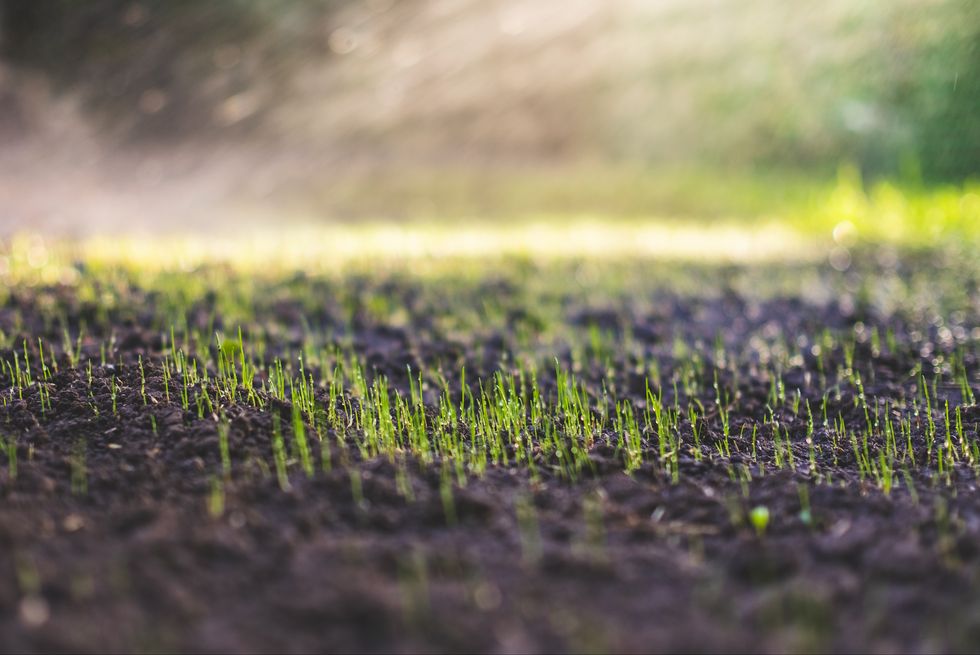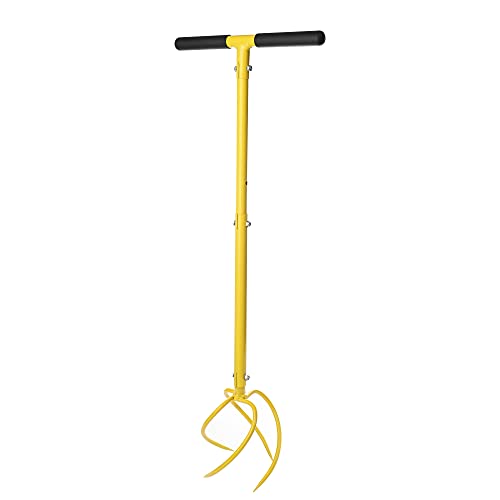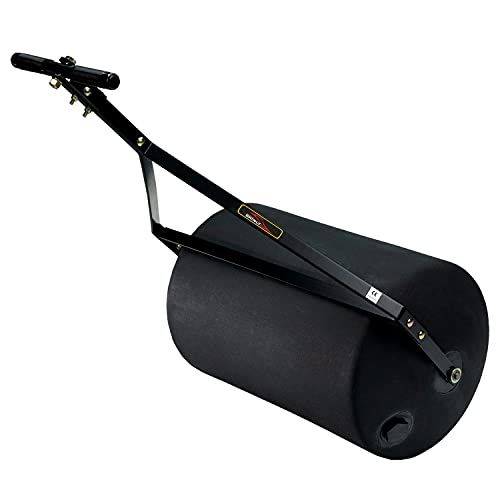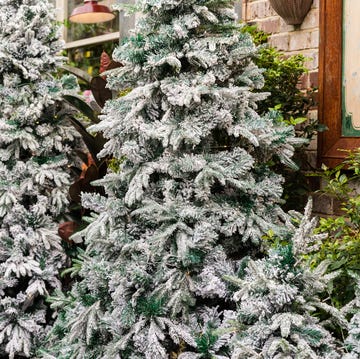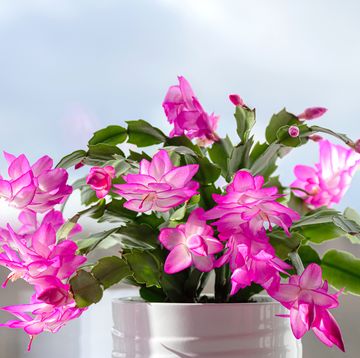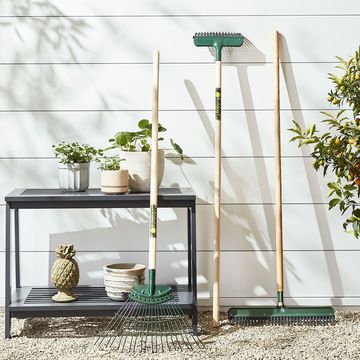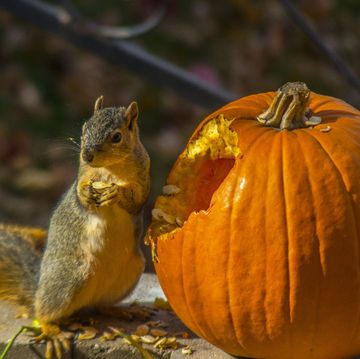If you've ever looked at the rolling fields and pastures of Drummond Ranch and wondered how you can have a yard that green, the first thing you need to know is: How to plant grass seed.
Whether it's a new lawn that needs landscaping ideas or simply patching thinning areas, you can't just throw down some seed and hope for the best. "Preparation is everything,” says Clint Waltz, PhD, turfgrass specialist at the University of Georgia. “The most important thing to remember is that seeds must make good contact with the soil in order to germinate. You also must get your grass established before environmental conditions become too hot or too cold for the young grass to survive.”
The good news is that planting grass seed is actually not that difficult, but you do need to take your time and make sure the area is ready for planting. Most homeowners can plant grass seed for the average-sized lawn (8,000 square feet) over a weekend. Just follow our steps below for how to plant grass seed and you'll be getting ready to mow in no time!
When can I plant grass seed?
The best time to plant grass seed is when grass is actively growing and that depends on where you live:
Generally, warm season grasses are found in the south. They grow during warmer months of the year from May to September. They need soil temperatures at least 65 degrees F (and past the last expected frost date in your area) for germination in the spring.
Cool season grasses are found in the north and grow during the cooler times of year, which is December to February. They require soil temperatures in the 55 to 65 degree F range to germinate.
Some parts of the country, such as the Mid-Atlantic states, have both types! If you’re not sure what species of grass you have, your local university coop extension service (find yours here) can help identify it. You can also check soil temperatures in your area here.
How do you prepare land for grass seed?
First, when planting seed, select the right species for your region and environmental conditions, such as sun or shade. “Grass is a plant like any other, if you don’t plant the right kind of grass in the right place, you’re doomed to fail,” says Waltz. Again, your local county coop extension service can offer guidance on what types grow best in your region.
Then, prepare the surface. Start with a blank slate and remove all sticks, stones, and scraggly grass or thatch. Till up the area 3 to 4 inches deep. Get a soil test (from your university county coop extension) to evaluate if you need to add anything such as phosphorous or potassium, or if you need to adjust soil pH by adding lime. “If needed, these materials should be tilled in before planting seeds,” says Waltz. If you have in-ground irrigation, check all the heads now before seeding.
Next, rake and smooth out the surface so there aren’t a bunch of lumps and bumps. Use a lawn roller to flatten out the area. “You want it firm so that it barely leaves a footprint when you walk across it,” says Waltz. Roll in two directions: First, smooth the area in one direction, then roll at right angles to the first passes. Now you’re ready to plant seed.
How do I plant grass seed?
Use a drop or rotary spreader, following the instructions of the local university coop extension service or the bag for the seeding rate. For example, the recommendation may be 5 to 6 pounds per 1,000 square feet. Set your spreader to the recommended setting, and start walking. Aim for even coverage; seeds shouldn’t be piled up on each other or completely covering every inch of bare soil because plants will spread out as they grow.
Ideally, split your coverage. That is, apply half of the seeds when walking in one direction, then the other half in a direction perpendicular to the first for better coverage so you aren’t accidentally skipping spots, says Waltz. Some experts say you need to rake it into the first quarter-inch of soil, but that’s not entirely necessary. Barely cover the surface with mulch, such as straw or pine straw, to keep seeds moist and prevent erosion.
Finally, turn on the water. Keep the area moist but not sopping wet—you can’t let it dry out because once germination occurs, your baby plants don’t have a reserve and will dry out fast. Depending on the type of grass, it can take a few days to a few weeks for it to sprout.
When can I mow new grass?
You can start mowing your lawn when the grass reaches its mature height. For example, tall fescue should be mowed around 3 to 3 ½ inches, while Bermuda should be mowed when it reaches 1 ½ to 2 inches tall. Don’t remove more than 1/3 of its leaf height when mowing—and hold off on watering a day or two beforehand so you won’t make tire ruts in the new lawn surface, says Waltz.
Also, wait to fertilize your grass until it has gone through two mowings, so that there’s a good root system established to take up nutrients, especially nitrogen. If you fertilize at planting, and then water to get grass to germinate, nutrients just leach out of the soil without a root system to use them, says Waltz.
How do I patch a hole in my lawn?
To patch a hole, plant the same species you already have growing so the lawn will have a more uniform appearance in texture and color. Then follow the same general steps as above: Remove all scraggly grass, weeds or sticks. Till up the area a few inches deep, or use a rotary hand cultivator to rough up the surface. Sprinkle on the seed, cover with a light sprinkling of straw, sand, or garden soil, and water.
But if you find yourself replanting the same spot year after year, maybe it’s time to rethink things. “It could be that soil has been compacted in that area, such as where the kids always play or underneath mature trees where grass doesn’t grow well,” says Waltz. “Sometimes, you’re better off replacing grass with something low-maintenance, such as pavers or ground covers.”
Arricca Elin SanSone has written about health and lifestyle topics for Prevention, Country Living, Woman's Day, and more. She’s passionate about gardening, baking, reading, and spending time with the people and dogs she loves.


